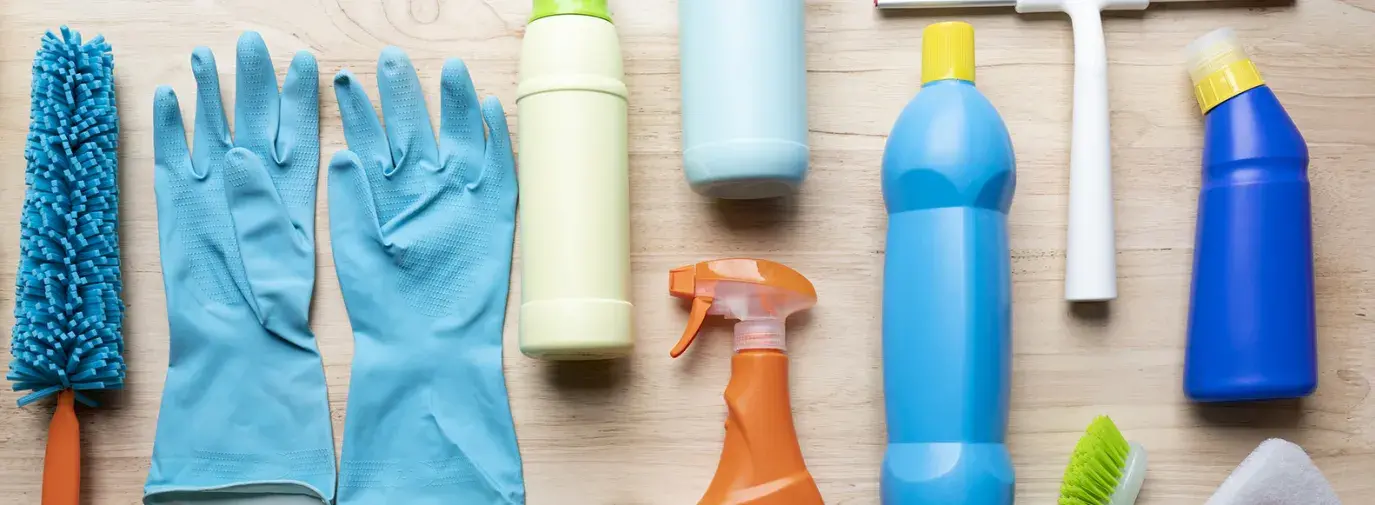
These widely-used, toxic chemicals may hide anywhere from skin cream to a frying pan. Let's explore what they are and where you can find them in your home.
Asbestos
A mineral that is resistant to heat and chemical corrosion and can be mixed with other materials to strengthen them. Though asbestos use has declined, it has not been banned in the US. Building materials still legally may be up to one percent asbestos, and old buildings are more likely to contain higher percentages. Homes should be checked for asbestos before any renovation—check roof and floor tiles especially. Asbestos fibers can be inhaled and accumulate in the body and cause inflammation, scarring, respiratory diseases, and cancer.
Benzyl benzoate
A common insecticide that is used medically to kill lice or scabies. It is also used as a food additive for flavor, in fragrances, and in plastics. It is a suspected neurotoxin.
Bisphenol-A (BPA)and Bisphenol-S (BPS)
Used to make transparent, hard plastic known as polycarbonate used for baby bottles and linings of metal cans. BPS is a common substitute for BPA since public outcry reduced use of BPA in plastics. Studies are showing the chemicals are similarly toxic. BPA/BPS are endocrine disruptors, and exposure may cause obesity, reproductive cancers, and infertility.
DEHP
A common class of phthalate—a liquid plasticizer used in hydraulic fluids and PVC plastic. It may leach into food and water through plastic and could cause damage to reproductive organs, lungs, kidneys, liver, and fetuses.
Endocrine disruptors
The endocrine system regulates hormones and the glands that secrete those hormones in the body. Endocrine disruptors (a.k.a. endocrine modifiers or hormone disrupters) are chemicals that interfere with the endocrine system by mimicking or inhibiting natural hormones. They can cause reproductive damage and have been implicated in cancers of the reproductive system.
Formaldehyde
(A.k.a. methanal, methyl aldehyde, or methylene oxide) A smelly, colorless, flammable gas used in pesticides, building materials, textiles, cosmetics, and home goods. The “new” smell of a mattress, piece of clothing, or car comes from formaldehyde. It is a carcinogen and suspected gastrointestinal, immune, nerve, reproductive, respiratory, and skin toxicant.
Lead
An abundant metal that may be found in a home in the form of old paint on toys or walls, in pipes, or in makeup. Lead is a neurotoxin that accumulates in the body and can cause brain damage and behavioral issues, and is especially harmful to children. There is no safe dose of lead.
Polybrominated diphenyl ethers (PBDEs)
Used as fire retardants in foam furniture, carpet padding, electronics, plastics, textiles, and building materials. PBDEs build up in people’s bodies over time and have been associated with tumors, delayed brain development, and thyroid issues.
Parabens
A preservative in pharmaceuticals and cosmetics, parabens are used in toothpaste, shampoo, moisturizers, and shaving gels. Parabens are endocrine disruptors that can be absorbed through the skin, and they have been linked to cancer.
Phthalates
A softening agent used in plastics and in a variety of beauty and skincare products. Studies have identified phthalates as endocrine disruptors. They may also cause liver and kidney lesions, lead to a higher risk of certain cancer, and exacerbate asthma and allergies in some children.
Per- and polyfluoroalkyl substances (PFAs)
PFAs are a class of chemicals including PFOA, PFOs, and GenX. They repel water and grease, so they’re used in the manufacturing of nonstick cookware, stain-resistant clothes and carpet, and even the inside of microwave popcorn bags. PFAs accumulate in the body over time and can lead to cancer, heart disease, and immune system damage.
Perifluorinated chemicals (PFCs)
PFCs repel grease and water, and are heat-resistant, so they’re popular in many products from fast food containers to paints, flooring, and furniture. Studies have linked them to cancer, thyroid issues, damage to immune and reproductive systems, high cholesterol, hypertension, and birth defects.
Volatile organic compounds (VOCs)
A category of chemicals that evaporate into the air and react with sunlight, which pollutes indoor air. The word “organic” means that these chemicals contain the element carbon. Formaldehyde is an example of a VOC that’s likely to be in your home. Some VOCs can be lumped under the term “fragrance” (though not all fragrances are VOCs). VOCs may cause eye, nose and throat irriation in the short term, and cancer, liver damage, kidney damage, and nervous system problems in the long term. VOCs pose a particular risk to infants and fetuses.
Ready to take action on toxic chemicals?
Read our room-by-room guide to detoxing your home. And take these six simple steps to a safer home.







